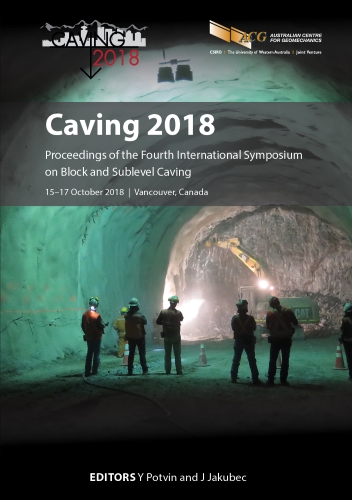Evaluation of caving as a mining method for the Udachnaya underground diamond mine project

|
Authors: Tishkov, M |
DOI https://doi.org/10.36487/ACG_rep/1815_66_Tishkov
Cite As:
Tishkov, M 2018, 'Evaluation of caving as a mining method for the Udachnaya underground diamond mine project', in Y Potvin & J Jakubec (eds), Caving 2018: Proceedings of the Fourth International Symposium on Block and Sublevel Caving, Australian Centre for Geomechanics, Perth, pp. 835-846, https://doi.org/10.36487/ACG_rep/1815_66_Tishkov
Abstract:
Hydraulic radius is calculated to assess the size of undercut to ensure the caveability of an orebody. There are two options for undercutting the kimberlite pipe of Udachny. Both options have a variety of configurations and design elements to create an area to initiate and propagate the cave. The first option has a single undercut horizon, while the second employs two undercut horizons. In the latter case, in addition to the primary horizon, there is another undercutting horizon to cave an upper block. The order of mining (eastern and western), the placement and spacing of drawpoints , the specific volume of infrastructure development mining, and the volume of mined ore columns are then determined.
References:
Benjavski, Z 1990, Upravlenie Gornym Davleniem, Mir Publishers, Moscow, p. 254.
Brown, E 2002, Block Caving Geomechanics, Julius Kruttschnitt Mineral Research Centre, The University of Queensland, Brisbane, p. 515.
Laubscher, D 2001, ‘Cave mining – state of the art’, in WA Hustrulid & RL Bullock (eds), Underground Mining Methods, Society for Mining, Metallurgy & Exploration, Englewood, pp. 455–463.
Malofeev, D 2007, Development of the Theory and Practice of Ore Drawing Under Caved Rocks, Siberian Federal University, Krasnoyarsk, p. 171.
Mawdesley, C 2002, Predicting Cave Initiation and Propagation in Block Caving Mines, PhD thesis, The University of Queensland, Brisbane.
© Copyright 2025, Australian Centre for Geomechanics (ACG), The University of Western Australia. All rights reserved.
View copyright/legal information
Please direct any queries or error reports to repository-acg@uwa.edu.au
View copyright/legal information
Please direct any queries or error reports to repository-acg@uwa.edu.au
